List of members |
Facilities |
Internships and jobs |
PhD |
Publications |
News |
Team
- Permanent Members: Jean-Yves Duquesne, Pauline Rovillain
- PhD Student: Louis Christienne
Magneto-striction, i.e. the coupling between magnetization and deformation, offers an original means of controlling magnetic properties. Thus, we use surface acoustic waves (rayleigh waves) to act dynamically on deposited magnetic thin films and manipulate their magnetic properties: magneto-caloric effect, magnetization, spin waves, spin current…
Surface waves
The rayleigh wave is a propagative elastic mode located on the surface of an object and whose depth of penetration is of the order of one wavelength. We excite and detect it electrically thanks to transducers lithographed on a piezoelectric material (gaas, linbo3, zno…). These transducers are in the form of two interdigital line arrays (see figure 1). Eventually, the teeth are divided to favour the operation on harmonics. The accessible frequency range is currently 0.1 to 5 ghz.
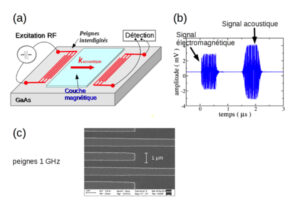
- Measurement by X-Ray diffraction ;
- Electrical measurement of the Sij Parameters of the acoustic quadrupole.
Acoustic spin pumping
At the interface between a ferromagnetic metal and a normal metal, the precession of magnetization generates a spin current in the normal metal. This effect is amplified at resonance. We study the current emission when the resonance is excited by a surface acoustic wave.

Figure 2: a) device (b) emission of a current in the time range where the acoustic wave train crosses the normal metal / ferromagnetic metal bilayer.
Resonant magnetoelastic coupling in Fe
The fe-thin films are epitaxied on a gaas substrate within the laboratory. Its very high crystalline quality allows us to know perfectly its crystallographic axes and thus its orientation and magnetic characteristics. We measure the variations in speed and attenuation of surface waves, in resonant regime, as a function of the applied magnetic field and the angle between it and the wave vector. We have shown the high angular sensitivity of the resonance conditions, alignment of the magnetic field with the axis [110] of fe.
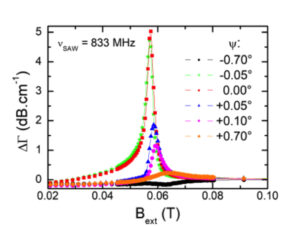
Figure 3: Attenuation Of Rayleigh Waves (Surface Acoustic Waves) As A Function Of The Magnetic Field. Observation Of High Angular Sensitivity, Loss Of Resonance To Within 0.1°.
Dynamic magneto-striction in FeGa
Fe1-xGax is a material with a very strong magneto-striction. We measure the variations in speed and attenuation of surface waves, in non-resonant regime, as a function of the applied magnetic field and the angle between it and the wave vector. The interpretation, in the framework of different models, is in progress and could give access to precise values of the magneto-strictive coefficients.
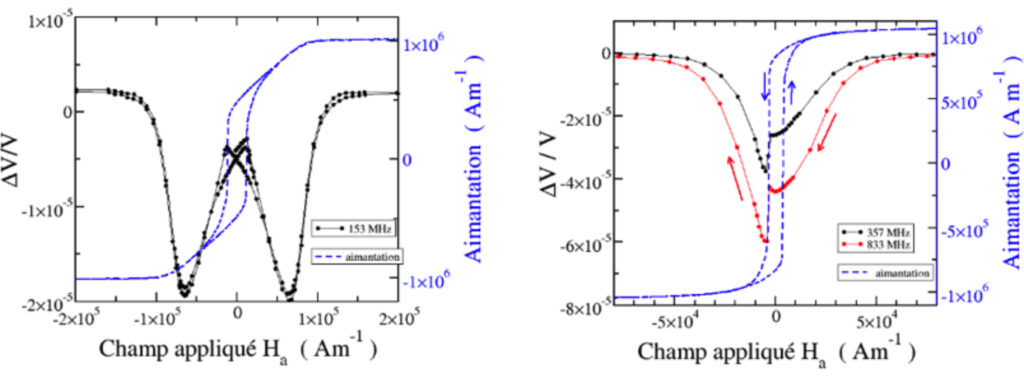
Figure 4: magnetization and speed of sound in fe80ga20 (a): 100 nm (magnetic structure with stripes). (b) 55 nm (magnetic structure without stripes).
MnAs is a ferromagnetic material with extremely strong magneto-caloric* properties (*temperature change under adiabatic field conditions, or entropy variation under isothermal conditions). We have shown that this effect can be dynamically triggered by rayleigh waves, in thin layers (100nm) epitaxial on gaas(001). It is manifested by very strong variations in attenuation and ultrasonic velocity (fig. 2). This work led to the filing of a patent for an ultra-sensitive thermometer.
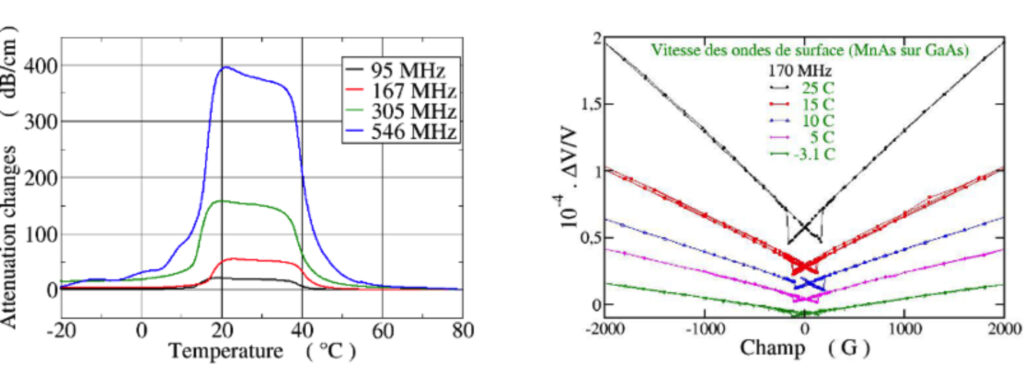
Figure 5: Attenuation and speed of rayleigh waves in MnAs/GaAs(100), as a function of frequency, temperature and magnetic field.reversal of magnetization in GaMnAsP.
Magnetization reversal in GaMnAsP
(Ga1-xMnx)(As1-yPy) is a semiconductor, ferromagnetic below 110k. Its magnetic properties can be modified by playing on the composition of manganese and phosphorus. On compounds with planar or perpendicular magnetization, a surface acoustic wave can induce:
- The excitation of ferromagnetic resonance, in linear and non-linear regime,
- The reversal of magnetization, in a wide angle precession process.
A kerr microscope coupled to an acoustic assembly allows to visualize the permanent reversal of the magnetization, at the end of non-linear excitation (figure 3a). The non-linear regime is also clearly observed on the behavior of the acoustic wave (figure 3b).
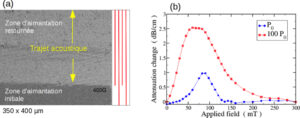
Figure 6: Reversal of magnetization, induced by a surface acoustic wave. (a) visualization in kerr imaging. (b) non-linear behavior of acoustic attenuation. P0 designates the acoustic power.
Main collaborations
- INSP – Team Growth and properties of thin film hybrid systems (M. Marangolo, M. Eddrief)
- INSP – Team Photons, magnons and quantum technologies (L.Thevenard et C.Gourdon)
Recent publications
- M. Kraimia, P. Kuszewski, J.-Y. Duquesne, A. Lemaître , F. Margaillan, C. Gourdon, and L. Thevenard, Time- and space-resolved nonlinear magnetoacoustic dynamics, Phys. Rev. B 101, 144425 (2020) https://hal.archives-ouvertes.fr/hal-02550724
- Delsing, P; Cleland, AN; Schuetz, MJA et al.,The 2019 surface acoustic waves roadmap,JOURNAL OF PHYSICS D-APPLIED PHYSICS 52 :53001 (2019) https://hal.archives-ouvertes.fr/hal-02184393
- J.-Y. Duquesne , P. Rovillain, C. Hepburn, M. Eddrief, P. Atkinson, A. Anane, R. Ranchal, and M. Marangolo, Surface-Acoustic-Wave Induced Ferromagnetic Resonance in Fe Thin Films and Magnetic Field Sensing, Phys. Rev. Applied 12 :024042 (2019) https://hal.archives-ouvertes.fr/hal-02271517
- I.S. Camara, J.-Y. Duquesne, A. Lemaître, C. Gourdon, and L. Thevenard, Field-Free Magnetization Switching by an Acoustic Wave, Phys. Rev. Applied 11 :014045 (2019) https://hal.sorbonne-universite.fr/hal-02187172
- J-Y Duquesne , C Hepburn, P Rovillain and M Marangolo, Magnetocrystalline and magnetoelastic constants determined by magnetization dynamics under static strain, Phys.: Condens. Matter 30 :394002 (2018) https://hal.archives-ouvertes.fr/hal-01871096
- P. Kuszewski, J.-Y. Duquesne, L. Becerra, A. Lemaître, S. Vincent, S. Majrab, F. Margaillan, C. Gourdon, and L. Thevenard, Optical Probing of Rayleigh Wave Driven Magnetoacoustic Resonance, Phys. Rev. Applied 10 :034036 (2018) https://hal.sorbonne-universite.fr/hal-01944664
- P. Kuszewski, I.S. Camara, N. Biarrotte, L. Becerra, J. von Bardeleben, W. S. Torres, A. Lemaitre, C. Gourdon, J.-Y. Duquesne, L. Thevenard, Resonant magneto-acoustic switching: influence of Rayleigh wave frequency and wavevector, J of Physics – Cond. Matter 30:244003 (2018) https://hal.archives-ouvertes.fr/hal-01812621
- I.S. Camara, B. Croset, L. Largeau, P. Rovillain, L. Thevenard and J.-Y. Duquesne, Vector network analyzer measurement of the amplitude of an electrically excited surface acoustic wave and validation by X-ray diffraction, J. Appl. Phys., 121:044503 (2017) https://hal.sorbonne-universite.fr/hal-01492868
- L. Largeau, I. Camara, J.-Y. Duquesne, C. Gourdon, P. Rovillain, L. Thevenard and B. Croset, Laboratory X-ray characterization of a surface acoustic wave on GaAs: critical role of the instrumental convolution, J.Applied Crystallography, 49:2073 (2016) https://hal.archives-ouvertes.fr/hal-01363432v1
- L. Thevenard, I.S. Camara, S. Majrab, M. Bernard, P. Rovillain, A. Lemaître, C. Gourdon and J.-Y. Duquesne, Precessional magnetization switching by a surface acoustic wave, Phys. Rev. B, 93:134430 (2016) https://hal.archives-ouvertes.fr/hal-01438602
- L. Thevenard, I.S. Camara, J.-Y. Prieur, P. Rovillain, A. Lemaître, C. Gourdon and J.-Y. Duquesne, Strong reduction of the coercivity by a surface acoustic wave in an out-of-plane magnetized epilayer, Phys. Rev. B (Rapid Comm.), 93:140405(R), (2016) https://hal.archives-ouvertes.fr/hal-01438587
- L. Thevenard, C. Gourdon, J.-Y. Prieur, H. J. von Bardeleben, S. Vincent, L. Becerra, L. Largeau, and J.-Y. Duquesne, Surface-acoustic-wave-driven ferromagnetic resonance in (Ga,Mn)(As,P) epilayers, Phys. Rev. B, 90:094401 (2014) https://hal.archives-ouvertes.fr/hal-01323921
- M. Marangolo, W. Karboul-Trojet, J.-Y. Prieur, V.H. Etgens, M. Eddrief, L. Becerra, and J.-Y. Duquesne, Surface acoustic wave triggering of giant magnetocaloric effect in MnAs/GaAs devices, Appl. Phys. Lett., 105:162403 (2014) https://hal.archives-ouvertes.fr/hal-01900335
- L. Thevenard, J.-Y. Duquesne, E. Peronne, H. J. von Bardeleben, H. Jaffres, Ruttala, J.-M. George, A. Lemaître, and C. Gourdon, Irreversible magnetization switching using surface acoustic waves, Phys. Rev. B, 87:144402 (2013) https://hal.archives-ouvertes.fr/hal-01324037
- J.-Y. Duquesne, J.-Y. Prieur, J. Agudo Canalejo, V. H. Etgens, M. Eddrief, and A. L. Ferreira, Ultrasonic triggering of giant magnetocaloric effect in MnAs thin films, Phys. Rev. B, 86:035207 (2012) https://journals.aps.org/prb/abstract/10.1103/PhysRevB.86.035207
Patent

